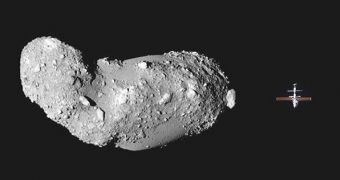For a long time, policymakers have dreamed about going to the Moon, or Mars, but also to near-Earth Objects, a class of celestial bodies including asteroids and meteorites, that are large enough to handle a spacecraft landing on them. Over recent months, this plan has been getting increased support from the American space agency, as well as from private companies involved in spaceflight research. In addition to the scientific results such a mission would return in itself, the flight would also test the limits of our hardware and prepare Mission Controls and astronauts for long-duration lunar and Martian flights.
It has recently become very obvious that the main hurdles facing a long-term flight to the Red Planet are not necessarily related to the available launch equipment or the structural integrity of a lander itself. Rather, this is the easy part. It's a lot harder, experts close to the issue say, to make astronauts get along for more than 2 and a half years, and also to minimize the effects of isolation on them. Additionally, preventing the emergence of diseases and protecting the crew from the effects of cosmic radiation are also high on the list of priorities, Space reports.
According to some briefing charts obtained from the aerospace company Lockheed Martin, the new project has been dubbed “Plymouth Rock – An Early Human Asteroid Mission Using Orion”. The Orion Crew Exploration Vehicle, an integrated part of NASA's Project Constellation, is being built by the company. The capsule will launch atop an ARES I rocket in 2015 at the earliest, though chances are high that the first flight will be delayed by at least a year. Regardless, scientists at Lockheed believe that Orion is capable of such a mission, which will see three astronauts on a NEO.
Experts at the company are also pondering the idea of setting up an astronaut-enabled telescope on one of these flying rocks, which could boost the level of astronomical knowledge currently available. And the mission is not as far-fetched as it would appear at first glance. In fact, the Lockheed team is thinking about meeting with NASA representatives on the issue as early as this week or the next. “We have been looking at what other interesting science missions could be done with Orion, and asteroids were one of the ideas that percolated to the top,” Josh Hopkins says.
The expert is employed with the Advanced Programs for Human Space Flight Division, at the Denver, Colorado-based Lockheed Martin Space Systems Company. He adds that sending Orion to a NEO is “an attractive option” and “really a good middle-step between the Moon and Mars.” Plans call for Orion to meet up with an Earth-Departure Stage (EDS) before leaving the planet's orbit, so that extra fuel, scientific payloads and food are made available to the astronauts. The EDS is to be put into orbit by an ARES V heavy-lift rocket, yet to be developed.

 14 DAY TRIAL //
14 DAY TRIAL //